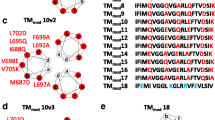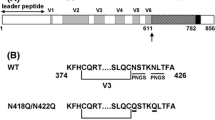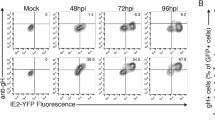Summary
Endoproteolytic processing of human immunodeficiency virus type 1 (HIV-1) gp160 membrane glycoprotein precursor into gp120 and gp41 is necessary for formation of infectious HIV particles [1]. We have studied the intracellular site of this processing using inhibition of transport at reduced temperature (20 °C). That reduced temperature (20 °C) inhibits the intracellular transport also in Jurkat-tat cells was demonstrated using the Semliki Forest virus p62 precursor processing as model. In HIV-1 infected Jurkat-tat cells the proteolytic processing of gp160 precursor did not occur when the protein was accumulated in the TGN at 20 °C temperature. When the temperature was shifted to 37 °C the HIV-1 gp160, which had accumulated in the TGN at the reduced temperature, was proteolytically processed. The processing of gp160 was inhibited when the temperature reversion was carried out in the presence of brefeldin A (BFA) or aluminium fluoride (ALFn) indicating that the exit from the TGN is required for the proteolytic cleavage of HIV-1 gp160 precursor. The results suggest that the processing of gp160 takes place at a yet unidentified transport step which is distal to the TGN/20 °C block site.
Similar content being viewed by others
References
McCune JM, Rabin LB, Feinberg MB, Lieberman M, Kosek JC, Reyes GR, Weissman IL (1988) Endoproteolytic cleavage of gp160 is required for the activation of human immunodeficiency virus. Cell 53: 55–67
Willey RL, Bonifacino JS, Potts BJ, Martin MA, Klausner RD (1988) Biosynthesis, cleavage, and degradation of the human immunodeficiency virus 1 envelope glycoprotein gp160. Proc Natl Acad Sci USA 85: 9580–9584
Earl PL, Moss B, Doms RW (1991) Folding, interaction with GRP78-BiP, assembly, and transport of the human immunodeficiency virus type 1 envelope protein. J Virol 65: 2047–2055
Pal R, Mumbauer S, Hoke GM, Takatsuki A, Sarngadharan MG (1991) Brefeldin A inhibits the processing and secretion of envelope glycoproteins of human immunodeficiency virus type 1. AIDS Res Hum Retroviruses 7: 707–712
Dewar RL, Vasudevachari MB, Natarajan V, Salzman NP (1989) Biosynthesis and processing of human immunodeficiency virus type 1 envelope glycoproteins: effects of monensin on glycosylation and transport. J Virol 63: 2452–2456
Merkle RK, Helland DE, Welles JL, Shilatifard A, Haseltine WA, Cummings RD (1991) gp160 of HIV-1 synthesized by persistently infected Molt-3 cells is terminally glycosylated: evidence that cleavage of gp160 occurs subsequent to oligosaccharide processing. Arch Biochem Biophys 290: 248–257
Kozarsky K, Penman M, Basiripour L, Haseltine W, Sodroski J, Krieger M (1989) Glycosylation and processing of the human immunodeficiency virus type 1 envelope protein. J Acquir Immune Defic Syndr 2: 163–169
Stein BS, Engleman EG (1990) Intracellular processing of the gp160 HIV-1 envelope precursor: endoproteolytic cleavage occurs in a cis or medial compartment of the Golgi complex. J Biol Chem 265: 2640–2649
Hallenberger S, Bosch V, Angliker H, Shaw E, Klenk H-D, Garten W (1992) Inhibition of furin-mediated cleavage activation of HIV-1 glycoprotein gp160. Nature 360: 358–361
Barr PJ (1991) Mammalian subtilisins: the long-sought dibasic processing endoproteases. Cell 66: 1–3
Stieneke-Gröber A, Vey M, Angliker H, Thomas G, Roberts C, Klenk H, Garten W (1992) Influenza virus hemagglutinin with multibasic cleavage site is activated by furin, a subtilisinlike endoprotease. EMBO J 11: 2407–2414
Garoff H, Frischauf A-M, Simons K, Lehrach H, Delius H (1980) Nucleotide sequence of cDNA coding for Semliki Forest virus membrane glycoproteins. Nature 288: 236–241
Kuismanen E, Saraste J (1989) Low temperature-induced transport blocks as tools to manipulate membrane traffic. Methods Cell Biol 32B: 257–274
Matlin K, Simons K (1983) Reduced temperature prevents transfer of a membrane glycoprotein to the cell surface but does not prevent terminal glycosylation. Cell 34: 233–243
Saraste J, Kuismanen E (1984) Pre- and post-Golgi vacuoles operate in the transport of Semliki Forest virus membrane glycoproteins to the cell surface. Cell 38: 535–549
Griffiths G, Simons K (1986) The trans-Golgi network: sorting at the exit site of the Golgi complex. Science 234: 438–443
de Curtis I, Simons K (1988) Dissection of Semliki Forest virus glycoprotein delivery from the trans-Golgi network to the cell surface in permeabilized BHK cells. Proc Natl Acad Sci USA 85: 8052–8056
Laemmli UK (1970) Cleavage of structural proteins during the assembly of the head of bacteriophage T4. Nature 227: 680–685
Crise B, Buonocore L, Rose JK (1990) CD4 is retained in the endoplasmic reticulum by the human immunodeficiency virus type 1 glycoprotein precursor. J Virol 64: 5585–5593
Barr FA, Leyte A, Mollner S, Pfeuffer T, Tooze SA, Huttner WB (1991) Trimeric G-proteins of the trans-Golgi network are involved in the formation of constitutive secretory vesicles and immature secretory granules. FEBS Lett 294: 239–243
Geyer H, Holschbach C, Hunsmann G, Schneider J (1988) Carbohydrates of human immunodeficiency virus: structures of oligosaccharides linked to the envelope glycoprotein 120. J Biol Chem 263: 11760–11767
Fennie C, Lasky LA (1989) Model for intracellular folding of the human immunodeficiency virus type 1 gp120. J Virol 63: 639–646
Thomas DJ, Wall JS, Hainfeld JF, Kaczorek M, Booy FP, Trus BL, Eiserling FA, Steven AC (1991) gp160, the envelope glycoprotein of human immunodeficiency virus type 1, is a dimer of 125-kilodalton subunits stabilized through interactions between their gp41 domains. J Virol 65: 3797–3803
Ohnishi Y, Shioda T, Nakayama K, Iwata S, Gotoh B, Hamaguchi M, Nagai Y (1994) A furin-defective cell line is able to process correctly the gp160 of human immunodeficiency virus type 1. J Virol 68: 4075–4079
Sariola M, Saraste J, Kuismanen E (1995) Communication of post-Golgi elements with early endocytic pathway: regulation of endoproteolytic cleavage of Semliki Forest virus p62 percursor. J Cell Sci (in press)
Takatsuki A, Tamura G (1985) Brefeldin A, a specific inhibitor of intracellular translocation of vesicular stomatitis virus G protein: intracellular accumulation of high-mannose type G protein and inhibition of its cell surface expression. Agric Biol Chem 49: 899–902
Fujiwara T, Oda K, Yokota S, Takatsuki A, Ikehara Y (1988) Brefeldin A causes disassembly of the Golgi complex and accumulation of secretory proteins in the endoplasmic reticulum. J Biol Chem 263: 18545–18552
Doms RW, Russ G, Yewdel JW (1989) Brefeldin A redistributes resident and itinerant Golgi proteins to the endoplasmic reticulum. J Cell Biol 109: 61–72
Lippincott-Schwartz J, Yuan LC, Bonifacino JS, Klausner RD (1989) Rapid redistribution of Golgi proteins into the ER in cells treated with Brefeldin A: evidence of membrane cycling from Golgi to ER. Cell 56: 801–813
Donaldson JG, Lippincott-Schwartz J, Bloom GS, Kreis TE, Klausner RD (1990) Dissociation of a 110 kD peripheral membrane protein from the Golgi apparatus is an early event in Brefeldin A action. J Cell Biol 111: 2295–2306
Lippincott-Schwartz J, Yuan L, Tipper C, Amherdt M, Orci L, Klausner RD (1991) Brefeldin A's effects on endosomes, lysosomes and TGN suggest a general mechanism for regulating organelle structure and membrane traffic. Cell 67: 601–616
Wood SA, Park JE, Brown WJ (1991) Brefeldin A causes a microtubule-mediated fusion of the trans-Golgi network and early endosomes. Cell 67: 591–600
Molloy SS, Thomas L, Van Slyke JK, Stenberg PE, Thomas G (1994) Intracellular trafficking and activation of the furin protein convertase: localization to the TGN and recycling from the cell surface. EMBO J 13: 18–33
Author information
Authors and Affiliations
Rights and permissions
About this article
Cite this article
Kantanen, M.L., Leinikki, P. & Kuismanen, E. Endoproteolytic cleavage of HIV-1 gp160 envelope precursor occurs after exit from the trans-Golgi network (TGN). Archives of Virology 140, 1441–1449 (1995). https://doi.org/10.1007/BF01322670
Received:
Accepted:
Issue Date:
DOI: https://doi.org/10.1007/BF01322670




